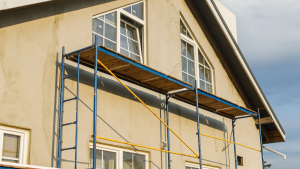1. Damp Looking Stucco
Getting the stucco wet should no longer be a cause for worry. After it has rained, it makes sense that it is wet. If it is still wet a week after the storm, it suggests that water has gotten into the stucco. There might also be wet spots on the wall. Pay special attention to those since there is where water may enter.
2. Cracks
A fissure in the stucco indicates that there is water in your stucco. However, you need not be concerned since this does not signify irreparable damage. It is, however, an indicator that water has gotten inside, and you must act fast before the situation worsens.
3. Missing Chunks of Stucco
Check your stucco to determine if any siding fragments have peeled off. The superficial deterioration indicates that water has gotten below and is creating issues.
4. Cracks and Bubbles at the Bottom of the Wall
Look for noticeable cracks or bubbles around the bottom borders during your inspection. Water, like everything else, must follow gravity and will flow downward. This suggests that most of the damage is expected to occur towards the wall’s base.
5. Window Caulking Damage
Can you find any cracks or holes in your window caulking? This also indicates that water has penetrated the stucco. If it’s been there for a long time, you’ll also have to replace the windows. That is why it is essential to examine the stucco on a regular basis.
6. Soft Drywall
You’re going inside now to finish your investigation. Feel for the drywall under your windows. Is it pleasant to the touch? This is another sign of water damage. In these cases, the drywall, as well as the external stucco, must be restored.
7. Basement Moisture
Finally, go into your basement and inspect the walls. You’ll notice that if there’s water in the stucco, it may cause wetness on the walls. This is one of many reasons this may happen, so rule out other possibilities before fixing the issue.


